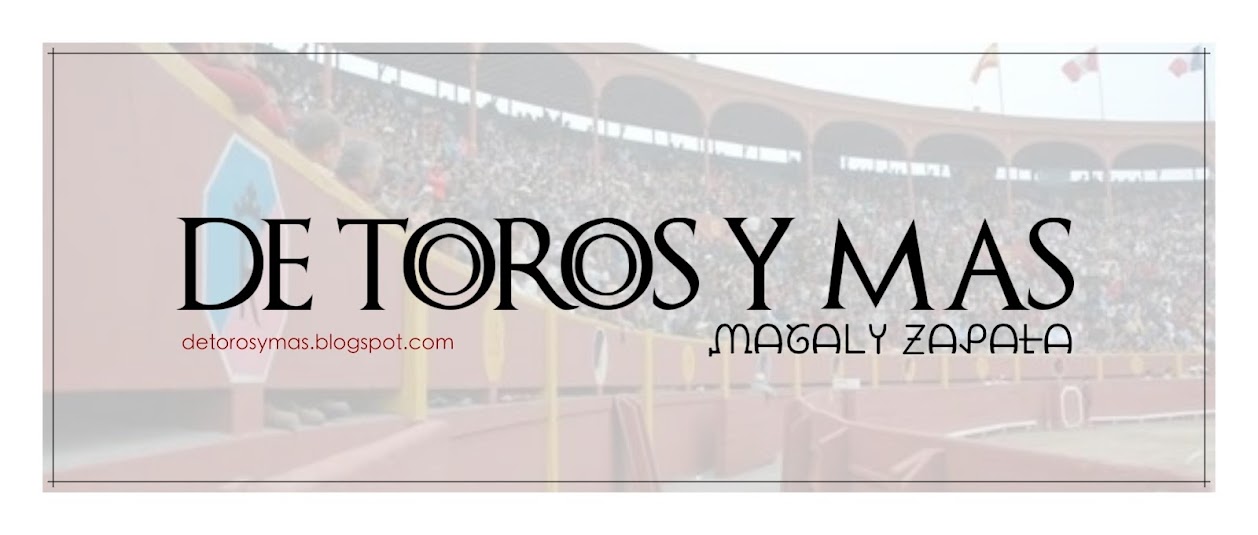Importantísimo el amplio artículo del diario más importante del orbe, sobre José Tomás. El artículo y fotos están en el link:
http://www.nytimes.com/slideshow/2009/09/30/arts/20091001_MATADOR_SLIDESHOW_index.html?scp=1&sq=bullfights&st=cse
El autor asegura que "José Tomás todavía atrae multitudes. Para los aficionados es la última y mejor esperanza para el toreo, como se llama la tauromaquia. Solitario, es un torero de la intrepidez sobrenatural y tranquila, llena de historia y misterio, que se retiró en 2002, a los 27 años y la altura de su fama, sólo para regresar de forma inesperada cinco años más tarde en Barcelona para lo que resultó la primera vez en veinte años que se vendieron los 19.000 asientos de la Plaza Monumental".
Michael explica en el diario más importante del mundo que "el toreo es una cuestión de patrimonio cultural español, dicen los aficionados. Europa podría unirse en torno a intereses comunes sociales y económicos, pero las culturas nacionales deben ser respetadas, y el toreo representa la diversidad cultural".
Michael Kimmelman escribe:
"Here in Catalonia, this persistently separatist-minded region of Spain, bullfighting has been in trouble for ages. And the economy hasn’t helped. Ticket prices are akin to opera’s. Fights are expensive to produce. The number of bullfights plummeted across Spain this year. But José Tomás still draws enormous crowds. For aficionados, he is the last best hope for toreo, as bullfighting is called. Reclusive, a matador of unearthly fearlessness and calm, steeped in history and mystery, he retired in 2002, at 27 and the height of his fame, only to return unexpectedly five years later in Barcelona for what turned out to be the first sellout in 20 years at the 19,000-seat Plaza Monumental, this city’s beautiful old brick-and-tile bullring.
Sunday he was back, for another special occasion: perhaps the last bullfight ever in Catalonia. Over the last three decades or so, dwindling interest among young Catalans has combined with pressure from animal-rights advocates and from Catalan nationalists to cripple toreo in Catalonia. Across the region’s four provinces, bullrings have closed; Barcelona’s is the only one still active. Now a referendum before the Catalan Parliament would end bullfighting here altogether. There has long been talk in this part of Spain about a total prohibition on toreo. Fans have played it down. But this time, even aficionados think a ban is likely to pass. So Sunday’s corrida — the term refers to an afternoon’s regular card of three matadors and six bulls — was more than just the last bullfight of the season. It was possibly the end of an era.
And José Tomás (José Tomás Román Martín, but everybody knows him by his double-barreled first name) had come, in what seemed almost like a last-ditch attempt, to lend his box office appeal and artistry to the anti-ban side. Artistry, that is, to aficionados. There is the art of the ritual, ancient and colorful, with its sequence of movements, firmly established but, because the bulls always vary, different each time, and entailing a kind of balletic grace on the part of the matadors, who are judged not least by whether they can make the bulls look graceful, too.
Bullfighting is a matter of Spanish cultural patrimony, fans say. Europe may wish to come together around common social and economic interests, but national cultures must be respected, and toreo represents cultural diversity. Opponents see it otherwise, of course. A dozen or so animal-rights protesters stood outside the arena Sunday, holding aloft handmade signs splattered with red paint. What’s clear is that during the early years of the last century, Barcelona had no fewer than three bullrings. It was a mecca for aficionados. There were more corridas here from the 1920s to the 1960s than in any other Spanish city.
But Catalan nationalists began to spread the notion that toreo was an imposition on Catalonia by Franco’s fascist regime, which promoted it, like flamenco, as a patriotic symbol. Opposition to bullfighting became a declaration of separatism by other means. Animal rights came along and fueled the nationalists’ agenda. That the issue remains, above all, political is demonstrated over the border, in the Catalan region of southern France, where bullfighting is embraced as fiercely as it is opposed in Spanish Catalonia, for exactly the same separatist reasons, in that case because it is banned in Paris.
It would be a mistake to conclude that an end to bullfighting here portends its prohibition across Spain. While nearly three quarters of Spaniards say they have no interest in bullfighting, they’re loath for foreigners to tell them what they can or can’t do. This is why Spain has consistently resisted pressure from the European Parliament and the European Court of Human Rights to end toreo. What will end it, if anything, is public indifference, competition from cheaper entertainment like soccer and video games, and the passing of a generation of aficionados.
And so, in the failing light of a warm early autumn afternoon, amid the bursts of flashbulbs and chants of 'Torero!' and 'Olé!' José Tomás appeared at least one last time in Barcelona, the standard-bearer for an afflicted art. He orchestrated his usual series of hair-raising passes with the bulls. Like Roger Federer, he makes every action look impossibly slow and stylish. His costume sparkled under the spotlights. A brass band struck up a pasodoble. The fans cheered as if somehow his sheer eloquence might, at the last minute, save toreo from extinction here. They tossed flowers, hats, scarves, notebooks and just about anything else they had at hand onto the blood-soaked sand as he circled the ring”.
